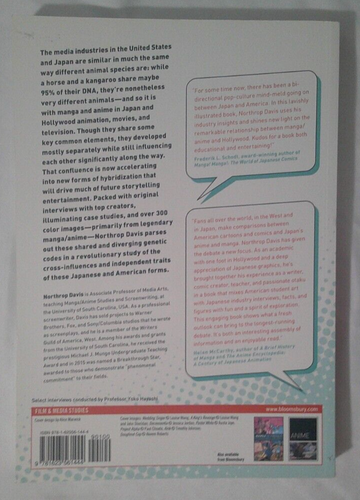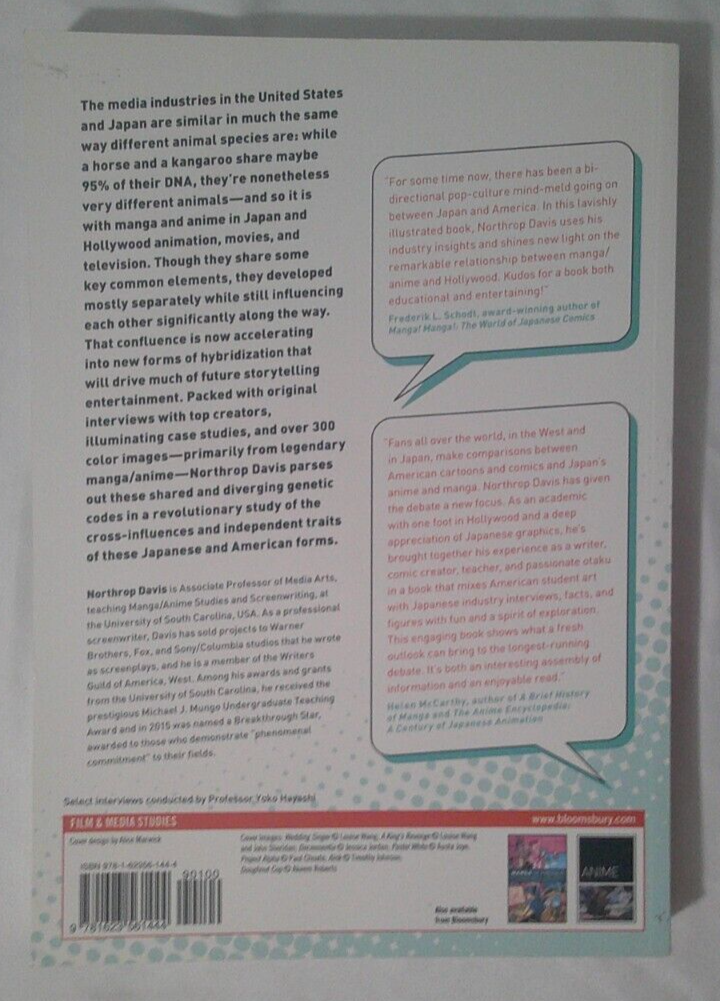Picture 1 of 6

Stock photo






Picture 1 of 6

Stock photo






Manga and Anime Go to Hollywood by Northrop Davis (2015, Trade Paperback)

C&S Treasures (160)
100% positive feedback
Price:
$35.99
Returns:
Condition:
Ghost in the Shell and. 🌏Discover How Japanese Pop Culture Shaped Hollywood!
Oops! Looks like we're having trouble connecting to our server.
Refresh your browser window to try again.
About this product
Product Information
The media industries in the United States and Japan are similar in much the same way animals on earth share a similar DNA, but while a horse and a kangaroo maybe 95% related on a biological level, they are also very different - this is the way it is with manga/anime in Japan and Hollywood animation/movies/TV. Although sharing some key common origins, they developed mostly separately but influenced each other significantly along the way. That confluence is now accelerating into new forms of hybridization that will drive much of future storytelling entertainment. Understanding these common and divergent DNA origins, the cross-influences and the independent traits is one of many reasons why this book is so important. ..Through original interviews with top creators in these fields and illuminating case studies including adaptations of Japanese mangas and animes for Hollywood remakes, Manga and Anime go to Hollywood analyzes the specific dynamics of this confluence between Japanese manga/anime and American film,animation and television. In addition, it shows how to use this knowledge creatively to shape the future of global narrative storytelling, including through the educational system. It is a fascinating to any reader with an interest in the inter-related history of Japanese manga/anime and Hollywood since the Meiji period through WW2, what is happening on the cutting edge right now - and into the future.Product Identifiers
PublisherBloomsbury Academic & Professional
ISBN-101623561442
ISBN-139781623561444
eBay Product ID (ePID)201729108
Product Key Features
GenrePerforming Arts, Comics & Graphic Novels
Publication Year2015
LanguageEnglish
Artist/WriterNorthrop Davis
TypeTextbook
FormatTrade Paperback
Dimensions
Item Length10.1in
Item Height0.8in
Item Width7in
Item Weight36.9 Oz
Additional Product Features
Number of Pages440 Pages
Publication NameManga and Anime Go to Hollywood
Lccn2015-018667
Dewey Decimal791.43/3409520973
Lc Classification NumberNc1766.U5d37 2015
Table of ContentChapter One: The Worldwide Success of Manga and Anime and an Overview of their Impact on Hollywood Chapter Two: Characteristics of Manga and Anime that Make Them Attractive to Hollywood for Adaptations Chapter Three: Wind from the East: Beginnings Chapter Four: Modern Manga is Developed Chapter Five: The Manga and Anime Industries Today Chapter Six: Anime is Born and Invades America Chapter Seven: Adaptations of Manga and Anime for American Television and Live-Action Movies Chapter Eight: Hollywood Adaptation Case Study #1: In Defense of Speed Racer Chapter Nine: Hollywood Adaptation Case Study #2: Astro Boy Chapter Ten: The Screenplay and Television Script Chapter Eleven: The Future of This Hybridity Afterword: Manga in Education and Practical Benefits of Creating Manga: Two Manga Production Teaching Examples Glossary of Terms
Reviews[This book] will surely be enjoyed by fans of anime but also by those interested in the world of film production., For some time now, there has been a bi-directional pop-culture mind-meld going on between Japan and America. In this lavishly illustrated book, Northrop Davis uses his industry insights and shines new light on the remarkable relationship between manga/anime and Hollywood. Kudos for a book both educational and entertaining!, "For some time now, there has been a bi-directional pop-culture mind-meld going on between Japan and America. In this lavishly illustrated book, Northrop Davis uses his industry insights and shines new light on the remarkable relationship between manga/anime and Hollywood. Kudos for a book both educational and entertaining!" - Frederik L. Schodt, award-winning author of Manga! Manga!: The World of Japanese Comics and other books on Japan "Fans all over the world, in the West and in Japan, make comparisons between American cartoons and comics and Japan's anime and manga. Northrop Davis has given the debate a new focus. As an academic with one foot in Hollywood and a deep appreciation of Japanese graphics, he's brought together his experience as a writer, comic creator, teacher and passionate otaku in a book that mixes American student art with Japanese industry interviews, facts and figures with fun and a spirit of exploration. This engaging book shows what a fresh outlook can bring to the longest-running debate. It's both an interesting assembly of information and an enjoyable read." - Helen McCarthy, author of A Brief History of Manga and The Anime Encyclopedia: A Century of Japanese Animation, "For some time now, there has been a bi-directional pop-culture mind-meld going on between Japan and America. In this lavishly illustrated book, Northrop Davis uses his industry insights and shines new light on the remarkable relationship between manga/anime and Hollywood. Kudos for a book both educational and entertaining!" - Frederik L. Schodt, award-winning author of Manga! Manga!: The World of Japanese Comics and other books on Japan "Fans all over the world, in the West and in Japan, make comparisons between American cartoons and comics and Japan's anime and manga. Northrop Davis has given the debate a new focus. As an academic with one foot in Hollywood and a deep appreciation of Japanese graphics, he's brought together his experience as a writer, comic creator, teacher and passionate otaku in a book that mixes American student art with Japanese industry interviews, facts and figures with fun and a spirit of exploration. This engaging book shows what a fresh outlook can bring to the longest-running debate. It's both an interesting assembly of information and an enjoyable read." - Helen McCarthy, author of A Brief History of Manga and The Anime Encyclopedia: A Century of Japanese Animation "In this educational and engaging book, Davis (media arts, Univ. of South Carolina) examines the elements and influences Japan's manga and the comics, animation, and movies of the US have in common. Although these media industries developed separately, they have exerted considerable influence on each other. In both Japan and the US, there is a close relationship between pop culture and graphics, and that relationship has resulted in new forms of media, storytelling, and creative expression--a sort of hybrid media industry that combines the highly successful models of Hollywood and Japan. In addition to creative and artistic influences, Davis considers the roles of business culture and legal culture--e.g., rights management and contractual obligations). The book is richly illustrated with examples of manga, anime, and adaptations to US television and movies. Especially enlightening are the interviews with media-arts professionals and the case studies that reveal the impact of collaborations between the Japanese and US entertainment industries. The book concludes with a discussion of the future of the hybrid media arts and a glossary of common terms in the industry. Summing Up: Recommended. All readers." - CHOICE
Dewey Edition23
Target AudienceCollege Audience
IllustratedYes
TopicFilm / Genres / Animated, Film / General, Television / General, Anthologies, Animation (See Also Film / Genres / Animated), Film / History & Criticism
All listings for this product
Be the first to write a review





















